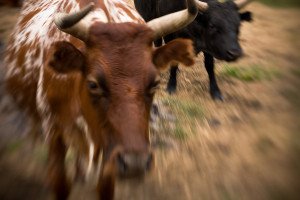Phil Immordino was literally looking for a bull market to bring back a controversial event that will likely to draw hundreds of weekend daredevils to the tiny city of Cave Creek, Ariz.
In what could be considered by some to be a liability nightmare, after a nearly 10-year-long hiatus Immordino is taking advantage of good insurance rates to conduct the 4th Running of the Bulls in America.
Modeled on Spain’s famous running of the bulls in Pamplona, the event on Oct. 14 and 15 in Cave Creek promises thrill seekers they will “experience an adrenaline rush of a life time by running a quarter mile in front of forty 1,500 lbs. raging bulls,” the event’s website states.
The number of participants at past events varied from 1,000 during the first event in 1998 to 700 runners the last year the event went off in 2002.
Based on responses so far, the event’s organizers say they expect hundreds of participants. “We’ll get over 500 runners,” Immordino said.
Immordino took a break from the event in 2002 following a successful third event, when insurance rates were on rise in the wake of the Sept. 11, 2011 terrorist attacks, making it tough to keep the event in the black and even tougher to find property owners with big enough insurance policies and in interest in playing host.
“After 9/11 all liability insurance went through the ceiling,” he said. “And we couldn’t find a location.”
Most of the property Immordino was looking at that could accommodate an event like his was on public property, and “those guys all wanted me to have $5 million in insurance.”
In fact, the Cave Creek City Council had originally asked Immordino to obtain $5 million worth of insurance, and a debate ensued that put the event in jeopardy. But the city council, which had originally issued a special events permit directly to Immordino, canceled the permit with him and issued it directly to the landowner to clear itself of liability concerns.
Immordino dismissed the debate about how much insurance he should be required to have, arguing the policies covering the event, the property and the bulls themselves, as well as any damage done should the bulls escape, are more than adequate, considering participants sign seven-page long liability release waivers.
“Runners sign waivers,” he said. “Technically runners can’t make an insurance claim anyways. They don’t have any rights whatsoever for an insurance claim. Even if they die they don’t have claim.”
That hasn’t stopped people from suing, and winning such suits in the past, but by putting on the Running of the Bulls with only $1 million in insurance, which he purchased through Scottsdale, Ariz-based Hill Insurance with Scottsdale Insurance as the underwriter, Immordino said he will be able to put on the event and stay in the black.
A Scottsdale spokesman could not be immediately reached for comment.
Immordino paid roughly $16,000 for the $1-million policy, a little over one-third of the $45,000 that a $5-million policy would have cost him, he said.
Brent Hill was the broker on the deal. He said his firm does primarily property and casualty, coverage of hospitals, and he’s involved in captive associations, but he doesn’t do many special events. He agreed to broker the deal because he knows Immordino through another association, he said.
Immordino runs the Golf Tournament Association of America. The GTAA is the association for all golf tournaments and events, such as fundraisers, corporate outings, networking and amateur competitive events.
Scottsdale made some recommendations for safety, which were carried out, Hill said, adding, “The carrier made some recommendations and we had to go through some underwriting guidelines.”
According to Immordino a variety of safety precautions have been taken, namely the bulls may be a bit tamer than their fiery Spanish counterparts.
“The ones you see in Pamplona are fighting bulls and these are regular rodeo bulls,” he said. “They’re not as aggressive.”
Reports state that roughly 200 to 300 people are injured during the event in Pamplona held in the first week of July each year, and 15 people have been killed since 1910. The event has been criticized by animal rights activists, including PETA.
At Cave Creek, organizers have constructed exit routes every 100 feet, and the fences are built so that “anybody can jump on the corral fencing and get over at any time,” Immordino said.
The event organizers have scheduled more than half-a-dozen emergency medical technicians to be on the track, and plan to give all runners safety instructions. As for crowd safety, there is a three-foot buffer with an orange snow fence between the corral fencing, and security guards in between to keep spectators away from the action, Immordino said.
“We don’t have as many people as the one in Spain,” he said. The Pamplona event typically draws about 7,000 runners.
According to Immordino, no serious injuries have occurred during his event in past years.
“We’ve never had a sniff of a claim,” he said. “Not even a sprained ankle. Just bumps and bruises.”
He noted that all runners are required to have their own health insurance.
Was this article valuable?
Here are more articles you may enjoy.

 Nearly 1,000 Feared Dead After Cyclone Hits France’s Mayotte
Nearly 1,000 Feared Dead After Cyclone Hits France’s Mayotte  Amazon Ignored Its Own Worker Safety Studies, Senate Report Says
Amazon Ignored Its Own Worker Safety Studies, Senate Report Says  Texas Accuses Allstate-Owned Arity of Data Privacy Violations
Texas Accuses Allstate-Owned Arity of Data Privacy Violations  Advocacy Groups Ask FIO to Release Homeowners Insurance Data Collected by NAIC
Advocacy Groups Ask FIO to Release Homeowners Insurance Data Collected by NAIC 